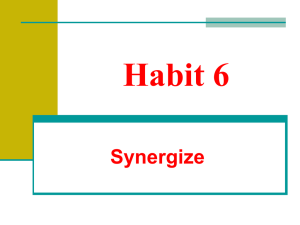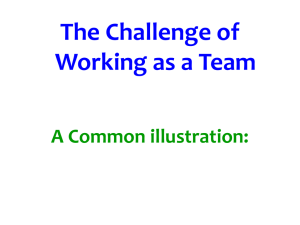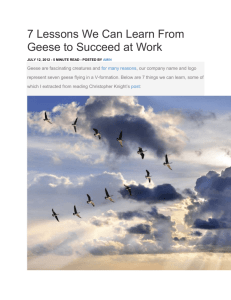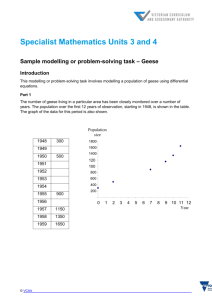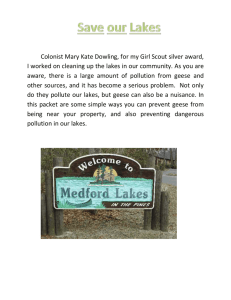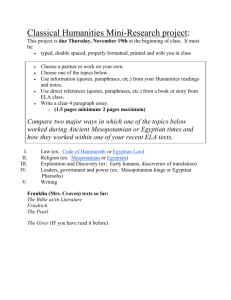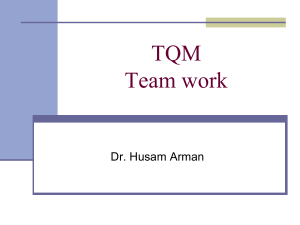Short Note Perceptions towards Egyptian Geese at the Steenberg
advertisement
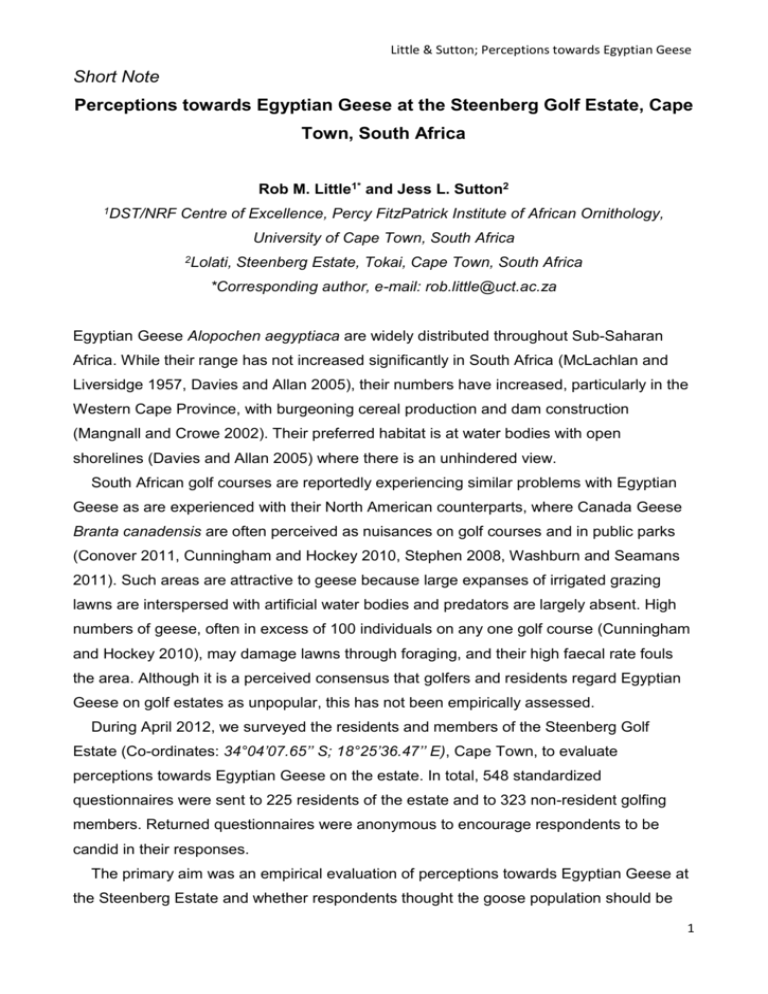
Little & Sutton; Perceptions towards Egyptian Geese Short Note Perceptions towards Egyptian Geese at the Steenberg Golf Estate, Cape Town, South Africa Rob M. Little1* and Jess L. Sutton2 1DST/NRF Centre of Excellence, Percy FitzPatrick Institute of African Ornithology, University of Cape Town, South Africa 2Lolati, Steenberg Estate, Tokai, Cape Town, South Africa *Corresponding author, e-mail: rob.little@uct.ac.za Egyptian Geese Alopochen aegyptiaca are widely distributed throughout Sub-Saharan Africa. While their range has not increased significantly in South Africa (McLachlan and Liversidge 1957, Davies and Allan 2005), their numbers have increased, particularly in the Western Cape Province, with burgeoning cereal production and dam construction (Mangnall and Crowe 2002). Their preferred habitat is at water bodies with open shorelines (Davies and Allan 2005) where there is an unhindered view. South African golf courses are reportedly experiencing similar problems with Egyptian Geese as are experienced with their North American counterparts, where Canada Geese Branta canadensis are often perceived as nuisances on golf courses and in public parks (Conover 2011, Cunningham and Hockey 2010, Stephen 2008, Washburn and Seamans 2011). Such areas are attractive to geese because large expanses of irrigated grazing lawns are interspersed with artificial water bodies and predators are largely absent. High numbers of geese, often in excess of 100 individuals on any one golf course (Cunningham and Hockey 2010), may damage lawns through foraging, and their high faecal rate fouls the area. Although it is a perceived consensus that golfers and residents regard Egyptian Geese on golf estates as unpopular, this has not been empirically assessed. During April 2012, we surveyed the residents and members of the Steenberg Golf Estate (Co-ordinates: 34°04’07.65’’ S; 18°25’36.47’’ E), Cape Town, to evaluate perceptions towards Egyptian Geese on the estate. In total, 548 standardized questionnaires were sent to 225 residents of the estate and to 323 non-resident golfing members. Returned questionnaires were anonymous to encourage respondents to be candid in their responses. The primary aim was an empirical evaluation of perceptions towards Egyptian Geese at the Steenberg Estate and whether respondents thought the goose population should be 1 Little & Sutton; Perceptions towards Egyptian Geese reduced, if at all. In this context, the concept of population reduction refers to reducing the attractiveness of the estate to geese, in order to reduce the number of geese visiting the estate, and not to the lethal or non-lethal removal of individuals from the estate. For most analyses, the percentage proportions were calculated for the actual number of responses to a particular question on the questionnaire, and not as a proportion of the total number of questionnaires completed. This is because not all respondents completed every question in all cases. Since quantitative research into the fluctuation or trends of Egyptian Goose numbers, or into the levels of damage caused by the geese, has not been conducted at the Steenberg Estate, the intention of this perception survey was only to understand attitudes towards the geese. It is the intention thereafter to follow this study with research into the design of golf courses to make them less attractive to Egyptian Geese. A total of 112 (20%) completed questionnaires were returned, 65 (58%) by residents of the estate and 47 (42%) by non-resident golfing members of the estate. The 65 residents were represented by 51 golfers and 14 non-golfing residents. Only 22 (22%) of the respondents thought that Egyptian Geese are indigenous to the Western Cape. However, there was a noticeable difference in this view between golfers and nongolfers, where 50% of the resident non-golfers knew that the geese were indigenous (Table 1). The majority of respondents (92 or 84%) considered that geese are a problem on the estate. However, when analysed as non-golfers versus golfers for this perception, only 8 or 57% of non-golfers perceived the geese as a problem (Table 1). The impacts of Egyptian Geese that were of most concern were that they cause mess in the form of excrement and that they harass other birds (Table 1). The majority of golfing respondents (81 or 87%) felt that the Egyptian Goose population requires active management. This was supported by the non-golfing residents, where 12 or 86% also felt this way (Table 1). Table 1: Proportional perception responses to the Egyptian Goose presence issue Resident Resident Non-resident non-golfers golfers golfers (n = 14)* (n = 51) (n = 47) (n = 98) Yes No Yes No Yes No Yes No Are Egyptian Geese indigenous to 7 7 9 37 6 35 15 72 the Western Cape? 50% 50% 20% 80% 15% 85% 17% 83% Do you consider the geese a 8 6 41 8 43 3 84 11 Questions All golfers 2 Little & Sutton; Perceptions towards Egyptian Geese problem on the estate? 57% 43% 84% 16% 93% 7% 88% 12% Do they obstruct your path (on the 2 6 25 23 23 24 48 47 course)? 25% 75% 52% 48% 49% 51% 51% 49% Do they cause mess, e.g. 13 1 44 6 45 1 89 7 excrement? 93% 7% 88% 12% 98% 2% 93% 7% Are they aggressive towards 3 10 26 22 13 33 39 55 humans? 23% 77% 54% 46% 28% 72% 41% 59% Do they damage greens or fairways? 3 6 25 22 29 13 54 35 33% 67% 53% 47% 69% 31% 61% 39% 8 4 32 10 33 7 65 17 67% 33% 76% 24% 83% 17% 79% 21% Do you think they require active 12 2 42 7 39 5 81 12 management? 86% 14% 86% 14% 89% 11% 87% 13% Do they harass other birds? *n = the overall number of questionnaires completed Of 104 respondents that indicated a perceived Egyptian Goose problem on the estate, the ranking levels of the perceived problem were: 16 (15%) minimal problem, 34 (33%) moderate problem and 54 (52%) severe problem. The majority (90 or 86% of all respondents) considered that the Egyptian Goose population should be reduced by 50% or more (Table 2). However, this attitude was less pronounced for the non-golfing residents, with 8 or 62% considering that the goose population should be reduced by 50% or more. Table 2. Respondents’ opinions regarding desirable levels of reducing the goose population Respondents The goose population should be reduced by: 0% 25% 50% 75% 100% 2 3 5 3 0 15% 23% 39% 23% 0% Golfers 5 4 21 40 21 (n = 91) 6% 4% 23% 44% 23% 7 7 26 43 21 7% 7% 25% 41% 20% Non-golfers (n = 13)* All respondents (n = 104) *n = the number of respondents to this question on the questionnaire 3 Little & Sutton; Perceptions towards Egyptian Geese It was interesting to note that a high proportion of respondents (79 or 78%) did not know that Egyptian Geese are indigenous to the Western Cape. This is pertinent in showing that humans often do not understand the basis of human-wildlife conflict issues, or that these issues often result from anthropomorphic alteration of the landscape. Indeed, the Steenberg Estate, like various other golfing estates in Cape Town, has been developed adjacent to natural wetlands, which influence the occurrence of waterfowl in the area and from which dispersal of Egyptian Geese will be ongoing. The fact that 84% of the respondents felt that Egyptian Geese are a problem and that 56% felt that the problem is severe, suggests that the problem is real and, unless management action of some form is taken, is unlikely to improve. Control measures previously undertaken by golf course managers in the Western Province have included displaying imitation owls, chasing the geese with dogs and motor vehicles, culling by shooting, destroying eggs and nests, and relocating geese. Culling or relocating the geese and chasing the geese with dogs were cited as the most successful control measures (Cunningham and Hockey 2010). The opportunistic behaviour of Egyptian Geese means that any control measures taken that include the removal of individuals will be ongoing and in all likelihood will be ineffective in the long term. A more effective approach might be to manipulate the design of a golf course, for example through a decreased size of open spaces and an increased distance to open water, so that the geese are less attracted to the environment. It is likely that the success of reducing the attractiveness of golf courses to geese will increase with the use of a number of different interventions, as suggested by Stephen (2008). While it is not necessary to eliminate geese from a property, managing their numbers at a level where they are tolerated by managers and golfers may be important. In South Africa, between 2.5 and 7% of the revenue from annual cereal crops is directly lost to Egyptian Geese (Mangnall and Crowe 2002). The economic value attached to their nuisance value on golf courses is more difficult to quantify. The costs involved in reducing goose numbers or eliminating their presence can be relatively high. Even simple scaring techniques rapidly become expensive. An initial design of any golf course to reduce its attractiveness to Egyptian Geese is preferable to reactive management. However, it is likely that geese will continue to utilise golf courses to some degree because of their fairways and water features. Reducing comfortable access by geese to food and water is the most effective means of 4 Little & Sutton; Perceptions towards Egyptian Geese control, but golf courses will likely always be attractive to some geese. A harassment technique, particularly by dogs, may best complement an alteration of golf course design, despite costs being relatively high. In general, the issue of dealing with Egyptian Goose numbers and activities on golf courses is a complex one. Both lethal and non-lethal management actions are available (Stephen 2008), as well as the preferred option of designing golf courses and their adjacent vegetation so that they are attractive to local bird species (Fox and Hockey 2007), while simultaneously being less attractive to Egyptian Geese. The results of this study will hopefully stimulate golf course managers to consider long-term approaches to addressing the issue and to implementing further research into rendering golf courses less attractive to Egyptian Geese. References Conover MR. 2011 Population growth and movements of Canada Geese in New Haven County, Connecticut, during a 25-year period. Waterbirds 34: 412-421. Cunningham SJ, Hockey PAR. 2010. Egyptian Geese and golf courses in the Cape Town area. Percy FitzPatrick Institute of African Ornithology, University of Cape Town. Unpublished report. Fox S-J, Hockey PAR. 2007. Impacts of a South African coastal golf estate on shrubland bird communities. South African Journal of Science 103: 27-35. Davies GBP, Allan DG. 2005. Egyptian Goose. In: Hockey PAR, Dean WRJ, Ryan PG. (eds), Roberts birds of southern Africa (7th edn). Cape Town: Trustees of the John Voelcker Bird Book Fund. pp 91-93. Mangnall MJ, Crowe TM. 2002. Population dynamics and the physical and financial impacts to cereal crops of the Egyptian Goose Alopochen aegyptiacus on the Agulhas Plain, Western Cape, South Africa. Agriculture, Ecosystems & Environment 90: 231246. McLachlan GR, Liversidge R. 1957. Roberts’ birds of South Africa (2nd edn). Cape Town: South African Bird Book Fund. Stephen V. 2008. A review of mitigation measures and their effectiveness in reducing the nuisance of geese on golf courses. PFIAO, UCT, unpublished MSc thesis. Washburn BE, Seamans TW. 2011. Foraging preferences of Canada Geese among turfgrasses: Implications for reducing human-goose conflicts. Journal of Wildlife Management 76: 600-607. 5 Little & Sutton; Perceptions towards Egyptian Geese Handling editor: RJM Crawford Received May 2012; Accepted November 2012 6
